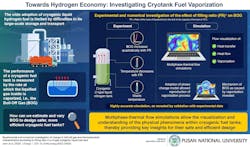Hydrogen is widely considered a critical fuel for the future of long-haul commercial transportation, but storing and transporting liquified hydrogen fuel at scale still faces serious challenges and safety limitations.
Now South Korean researchers are searching for safer and more efficient ways to design cryogenic tanks, or cyrotanks, by investigating the heat flows and phase changes within the tanks using multiphase thermal flow simulations. The researchers recently detailed their findings in the paper “Experimental and numerical investigation of change in boil-off gas and thermodynamic characteristics according to filling ratio in a C-type cryogenic liquid fuel tank.”
Concerns about climate change have prompted the move away from fossil fuels to alternative energy sources, and hydrogen fuel is one of the most promising in transportation, but presently most hydrogen fuel is transported as high-pressure gas in specialized tanks, a technique that is both “inefficient and poses serious safety concerns,” researchers say. Using liquified hydrogen fuel in storage and transport could overcome these challenges.
Liquified hydrogen fuel only can be transported in cryotanks, which maintain temperatures below 253 degrees C, which is hydrogen’s boiling point. Despite thermal insulation, liquefied fuel still experiences a degree of vaporization, with the flow rate measured as “boil-off gas” (BOG). If BOG is too high, it can result in excess internal pressure inside the tank, leading to cracks and fissures, so understanding and controlling BOG a key factor in cryotank design.
To this end, the research team, led by Jong-Chun Park, a professor at Pusan National University in South Korea, investigated how BOG varies with another critical design parameter called tank filling ratio (FR), which is the ratio of the mass of liquefied fuel in the tank to the capacity of the tank at 15 degrees C. “In our study, we performed experiments, as well as simulations, to analyze the thermodynamic characteristics of the tank,” Park explained. The study was made available online last June and published in the Energy journal in September.
From their experiments, researchers found BOG increases quadratically with FR. They also found that while the temperature within the liquid phase remained constant, the temperature of the vapor phase decreased non-linearly with FR. The researchers then performed multiphase thermal flow simulations of the tank using computational fluid dynamics. This allowed them to easily visualize the heat transfers, thermal flows, and vaporization within the vacuum-insulated tank.
“We adopted the Rohosenow’s phase change model for the simulations, which allowed us to reproduce the vaporization process within the tank,” Park said. “From our simulations, we were finally able to reveal the mechanism of BOG as a result of vaporization.” The researchers validated their simulations using data from the experiments conducted through a collaboration with Daewoo Shipbuilding & Marine Engineering Co.
Their multiphase thermal simulation technique could accelerate the design of safe and efficient commercial cryotanks for liquefied hydrogen, researchers said.
Click here to read the full research paper.

